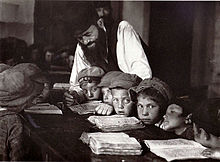Cheder
Cheder ( חֶדֶר, Plural חֲדָרִים Chadarim or Ashkenazi Hebrew and Yiddish Chejder, plural Chadorim ) is the Hebrew word for "room" and the name for the traditional, religious schools, as they were in Western European Judaism up to the end of the 18th century, in Eastern European Judaism up to Holocaust were common.
Shape and curriculum
Classes in the cheder took place in the teacher's house, which was financed by the Jewish community or a group of parents. The cheder was usually associated with the synagogue . This form of upbringing was usually only available to boys; girls mostly learned from their mothers on the side. Classes were held in small groups with boys of different ages.
The boys entered the cheder when they were about three years old. First learned the Hebrew alphabet and the Hebrew language (slang of European Jewry was from the Middle Ages to the Enlightenment , the Yiddish ). On this basis, they then studied the Torah , beginning with the 3rd book of Moses , and then the Talmud , i.e. H. Mishnah , Gemara and additional comments. Mutual reading aloud and memorization were the predominant forms of learning. Between the ages of 13 and 14, training in cheder was completed with a bar mitzvah . During this ceremony, the adolescent boy, who is also called Bar Mitzvah (literally “son of the commandment”) on this occasion, reads a passage from the Torah during a service in front of the congregation .
For further study to become a rabbi or sofer there was a yeshivot , i.e. H. Talmud universities, for example in Worms , Fürth or Prague , which enjoyed a high reputation for Jewish studies. After many Jews fled to Eastern Europe from the pogroms of the Jews in connection with the Crusades in the Middle Ages , the intellectual center of European Jewry for many centuries lay in this region.
criticism
The cheder system was criticized by both Jewish Orthodoxy and Haskalah supporters at the end of the 18th century .
The Orthodox side especially criticized the often inadequate qualifications of the teachers, who were mostly poorly paid and, especially in small villages, still worked as shochet , prayer leader or gravedigger and were therefore only able to teach part-time. It was also not uncommon for teachers to let the children advance to the next level of studies too early because they received a little more money for advanced students than for elementary lessons.
Enlightenment supporters criticized the whole system because it hindered the integration and emancipation of the Jews through its linguistic and spatial isolation from the Christian environment . They spoke out in favor of additional lessons in German and demanded the inclusion of secular and professional content. Enlightened German-speaking Jews have achieved these goals since the end of the 18th century by setting up reform schools , also known as “free schools ”. An example of such a free school was the Jewish Free School in Berlin . The reform schools movement and the introduction of compulsory education in the 19th century led to the dissolution of the cheder system in German-speaking countries. In Eastern Europe, training in cheder continued in many places until the Holocaust.
present
Even today there are Chadarim in Charedic communities, for example in Antwerp , London , Zurich , New York and Jerusalem . In contrast to the previous organization in the rural areas of Eastern Europe, the Chadarim are now well organized, the children of a year are grouped into classes, the teachers (Rebbes) are trained.
In the United States , children from non-Orthodox Jewish families usually attend a Hebrew School , the Jewish equivalent of Sunday School, in addition to regular schooling .
literature
- Marion Kaplan: History of everyday Jewish life in Germany from the 17th century to 1945. Munich 2003.
- Simone Lässig : Jewish Paths to the Bourgeoisie. Göttingen 2004 (especially on reform schools).
- Berl Kagan, Nathan Sobel: Luboml. The Memorial Book of a Vanished Shtetl. KTAV Publishing House, Brooklyn / New York 1997, ISBN 978-0-88125-580-5 , p. 53 f.
Web links
Individual evidence
- ↑ Barbara Binder Kadden, Bruce Kadden: Teaching Jewish Life Cycle. Traditions and Activities. ARE Publishing, 1997, ISBN 0-86705-040-3 , p. 26.
